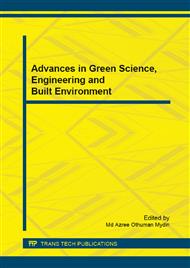p.209
p.213
p.217
p.221
p.226
p.230
p.234
p.238
p.242
The Influence of Compressive Strength of EPS Concrete Using Fiberglass with Curing and Non Curing Treatment
Abstract:
Concrete is a mixture of portland cement, fine aggregate, coarse aggregate and water, with or without additives which form a solid mass. The purpose of this study was to find and innovative method of producing concrete mix from solid waste material as alternative. The alternative materials used in concrete mix was fiberglass. Material reduction in the sand on the concrete can decreases the strength until the fiberglass material added and increase the compressive strength on concrete. The composition of fiberglass that used in this study was 0%, 0.5%, 1%, 1.5%, 2%, 2.5%. The methodology used is the design of concrete mix in according to SNI 03-2834-2000. The results are concrete with the addition of EPS can reduce the density and the compressive strength of normal concrete, concrete EPS was added to increase the value of compressive strength fiberglass. The addition of fiberglass in concrete EPS only on the variable of 0.5% - 1% fiberglass, if greater than 1%, the compressive strength of concrete decreased because the material has not homogeneous concrete during mixing. The largest density value of 10% EPS concrete with fiberglass on the concrete test 28 days is the concrete EPS 10% + 0.5% fiberglass by weight of the curing process and the type of 2127.73 MPa and compressive strength are the largest and EPS concrete with compressive strength amounted to 11.277 MPa. The addition of 10% EPS can reduce the compressive strength of concrete at 3.75%. The addition of fiberglass obtained with a percentage of 0.5% - 1% is the most effective additions so as to improve the quality of concrete by 0.74%. Concrete with compressive strength has a curing system which is much better than the non-curing concrete, because concrete experience of concrete hydration reaction process which takes place optimally.
Info:
Periodical:
Pages:
226-229
Citation:
Online since:
March 2015
Authors:
Keywords:
Price:
Сopyright:
© 2015 Trans Tech Publications Ltd. All Rights Reserved
Share:
Citation:


